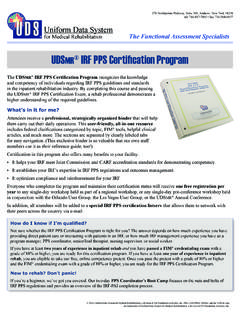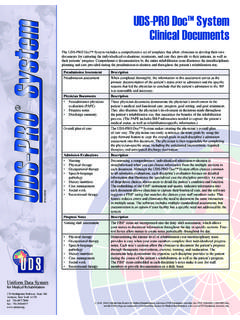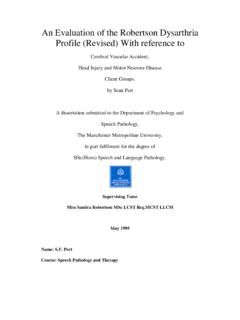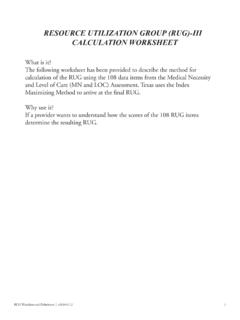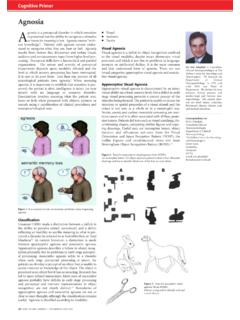Transcription of The FIM Instrument: Its Background, Structure, and Usefulness
1 270 Northpointe Parkway, Suite 300, Amherst, New York 14228. tel: 716-817-7800 fax: 716-568-0037. Uniform Data System for Medical Rehabilitation The Functional Assessment Specialists The fim instrument : Its background , structure , and Usefulness 2012, 2014 Uniform Data System for Medical Rehabilitation. AcuteFIM, AlphaFIM, FIM, LIFE ware, SigmaFIM, The FIM System, WeeFIM, WeeFIM II, ZetaFIM, UDSMR, and the UDSMR logo are trademarks of Uniform Data System for Medical Rehabilitation, a division of UB Foundation Activities, Inc. Prepared by: Uniform Data System for Medical Rehabilitation, a division of UB Foundation Activities, Inc. 270 Northpointe Parkway, Suite 300, Amherst, New York 14228.
2 Citation: Uniform Data System for Medical Rehabilitation. 2012. The fim instrument : Its background , structure , and Usefulness . Buffalo: UDSMR. This document may be reproduced or transmitted for internal purposes only. However, no part of this document may be modified, reproduced, or otherwise transmitted in any form or by any means (electronic, mechanical, photocopying, recording, or otherwise), or used to make any derivative work (such as translations and adaptations) without prior written permission from Uniform Data System for Medical Rehabilitation. Address inquiries regarding copyright information to: Legal Services Uniform Data System for Medical Rehabilitation 270 Northpointe Parkway, Suite 300.
3 Amherst, NY 14228. The fim instrument : Its background , structure , and Usefulness The Uniform Data System for Medical Rehabilitation, July 8, 2014. Functional Assessment Contents Specialists 1. background .. 1. structure .. 3. Usefulness .. 12. Program Evaluation Model (PEM) .. 12. Burden of Care (BoC) .. 13. Explanation of Rasch Analysis .. 15. Continuum of Care .. 18. Uniform Pharmaceutical Research Trial .. 18. Precision Case Management .. 18. Data The WeeFIM Instrument and the WeeFIM Instrument: 0 3 Module .. 22. System Summary Overview for Teaching Purposes: Use of the fim instrument in Practice .. 23. Additional Reading .. 28. for Medical Rehabilitation Telephone Fax E-mail Web site Suite 300.
4 270 Northpointe Parkway Amherst, NY 14228. i Introduction A gerontologist in Philadelphia, M. Powell Lawton, wrote in 1971 the first definition of functional assessment. He said that functional assessment was any systematic attempt to objectively measure the level at which a person is functioning in a variety of domains. Functional assessment, as a scientific endeavor, was slow to develop in rehabilitation. In fact, during the 1970s, most clinicians regarded functional assessment as an effort to measure the unmeasurable. 1. background Although inpatient rehabilitation has been widely practiced since the 1950s, the field lacked an agreed- upon method of accounting for degrees of independence versus dependence in a person's performance of basic personal care activities.
5 Thus, neither the outcomes nor the benefits of inpatient rehabilitation were objectively evaluated or measured. Consistently and predictably quantifying attributes of health beyond organ-based descriptors of physical manifestations and symptoms has been difficult. Early explorations were extremely complex being interrelated and difficult to separate while being value- laden and not easily quantified. 2. Examples of early attempts to quantify what we now recognize as various expressions of latent traits . include the PULSES profile 3 and the Barthel index. 4. The Barthel index (BI) is used to gauge motor performance of rehabilitation inpatients in some centers, but it has one level for independence and only two levels for assistance.
6 Thus, it is not sensitive to gradations between dependence and independence, and it does not relate to the extent of effort provided by the person who helps perform daily personal care activities ( , the burden of care, or BoC). Also, the BI does not address cognitive functioning. In traditional thinking, activities of daily living (ADLs). are mainly physical functions, but cognitive functions are necessary, even if less obvious. In 1987, after three years of project development, a review of thirty-six published functional assessment instruments , and testing, the fim instrument was created. It was endorsed by the American Academy of Physical Medicine and Rehabilitation and the American Congress of Rehabilitation Medicine.
7 The fim instrument was intended to address the challenges to neuroscience research with respect to the predictable relationship between the treatment or intervention afforded the person with disablement and the response of that person. It was necessary for the fim instrument to be criterion-referenced and administered by trained and tested clinicians in order for assessments of functioning to be uniform across different certified raters. The result is objective assessments that permit comparison of results between different sites and patients over time, whether treatment modalities are similar or different. Patients are admitted to an inpatient rehabilitation facility because they are functionally dependent upon others to meet their daily personal care needs.
8 The essential purpose of intensive (or acute) inpatient rehabilitation is to promote and achieve functional independence, primarily in personal care, and, within limitations imposed by disease or injury, to enable the person to regain normal or near-normal levels of participation in usual activities. The fim instrument is also used in selected skilled nursing facilities that emphasize rehabilitation and in a few long-term acute care hospitals. Use of the fim instrument enables the members of the interdisciplinary rehabilitation team to be continually aware of the progress being achieved by each team member and by the team as a whole. As a rule, most patients gain one or 1. Lawton M. The functional assessment of elderly people.
9 JAGS. 1971;19(6):465 481. 2. Granger CV, Gresham GE, eds. Functional Assessment in Rehabilitation Medicine. Baltimore: Williams 1984, page x. 3. Moskowitz E, McCann CB. Classification of disability in the chronically ill and aging. J Chronic Dis. 1957; 5:342 346. 4. Mahoney FI, Barthel DW. Functional evaluation: the Barthel index. Md State Med J. 1965;14:61-65. The fim instrument : Its background , structure , and Usefulness two FIM points per day. It is useful to compare the full FIM rating at admission with ratings recorded ten days after admission. At that time, areas of greater need can be identified, and treatment can be adjusted. The attention given to the FIM ratings is the qualifying difference when a patient is admitted to inpatient rehabilitation.
10 Continuous improvement in a patient's function validates the team's effectiveness. We call using the fim instrument in this way precision case management.. Knowing the effects of intensive rehabilitation in quantitative terms is essential to achieving evidence- based, or evidence-guided, practices targeted toward recovery of functional health. As well, functional assessment provides a means for compiling a database that meets the informational needs of both administrators and clinicians. 5 The diagnosis-related group (DRG) system had been recognized as suitable for prospective payment for acute hospital care, but it did not adequately adjust for severity at the level of patient functioning.





